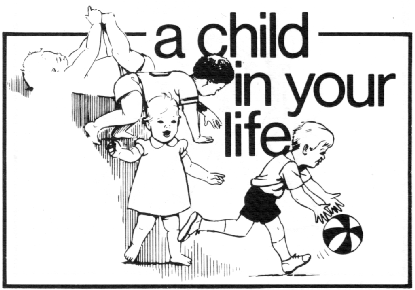
CFS-177

Eating is an important time for your family. Mealtime is a social time. It might be the one time during the day when the whole family is together. Mealtime can also be a problem time with a child. We hope this information will help to make mealtime a good time for you and your family.
The main food for an infant during the first 6 months is breastmilk or formula.
There are good reasons to breastfeed.
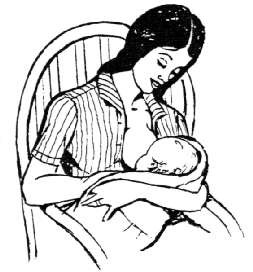
You may either sit or lie down while breastfeeding. Just get comfortable and relaxed. If you are sitting:
Start breastfeeding by moving the baby close to your nipple. Guide the nipple into the baby's mouth. The baby's mouth should press on the dark area around the nipple. Feed the baby for 10 or 15 minutes. Burp the baby. You may want to change his diapers. Then switch to the other side.
Things to remember if you are breastfeeding:
Breastfeeding is a very good way to feed a baby. But some mothers would rather bottle feed. Bottle feeding is okay for your child. It can be just as rewarding as breastfeeding. Formula is good for babies, too.
1.Read the instructions on the formula package. Follow the instructions care fully.

2.Be careful to add the right amount of water to the formula. Adding too much water is not good for the baby. Not enough water is bad, too.

3.Make sure all the bottles are very clean before using them. Wash the bottle, nipples, and can opener in hot, soapy water and rinse them well. Wash them before you wash other dishes in that water. If you have well water, ask your doctor if you need to boil bottles and nipples.
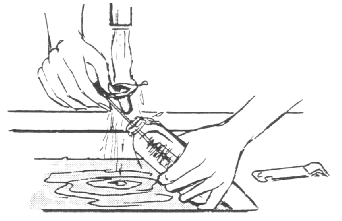
4.Be sure to tighten the ring around the nipple so it fits.
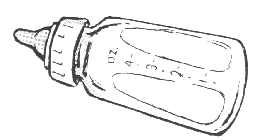
Feeding the Baby with a Bottle
1.Hold the baby when you feed him or her. Make sure the baby's head is a little higher than the rest of the body.

2.Hold your baby close for feeding. Do not set up the bottle for the baby to drink alone. This may cause ear aches, choking, and "nursing bottle mouth" (rotten teeth). This is because the baby can fall asleep with formula or juice in the mouth. Also, the baby misses out on hugs and being close to you.
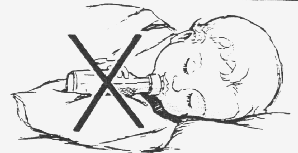
3.Keep the bottle tipped a little while feeding the baby. This keeps the nipple filled with formula. This keeps the baby from swallowing a lot of air and should stop him from getting a stomach ache.
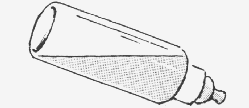
4.The baby will stop eating when he or she is full. Sometimes there still will be formula in the bottle. Do not try to make the baby take it all. Babies know when they are full.
5. Bottles should be used only for formula or water. When your baby is ready to drink juice, try a cup.
Many parents like to start early with "real" food. Some people think a little baby who is eating from a spoon looks smarter or grown-up. But slow down. Be careful about starting your baby on solid foods. Talk to your doctor or dietician about when to feed your child solid foods. Ask what kind of foods are best. Most doctors will say the baby should be at least 4 months old. Some will say 6 months old.
Feeding solid foods to a very little baby may lead to problems. The baby may get too much food. Other babies may become allergic to foods.
Your baby will tell you when he or she is ready to eat solid foods. Watch your baby. Does he sit up, drool, and open his mouth when something is moving toward his mouth? This means he is probably ready for solid foods.

1. Try to be in a good mood and relax.
2. Try to make sure the baby is a little hungry.
3. Hold the baby in a sitting position. Or put her in a high chair.
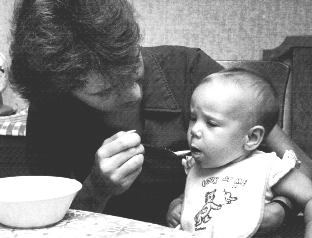
4. Use a small, skinny spoon to fit the baby's mouth.
5. Put a little food on the spoon. Put the food toward the back of the baby's mouth.
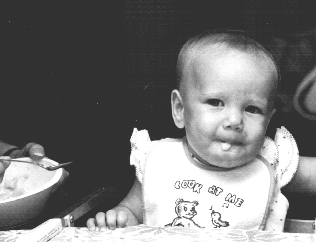
6. The baby may spit out the food. This is because he may not know how to chew it.
7. Give the baby another bite even if she spits out the first bite.

8. If the baby will not eat something, do not force him. Wait and try feeding him the food later.
9. The baby needs to learn to eat from a spoon. Never mix the baby's food with her formula in a bottle or infant feeder.
10.Later your child will begin to grab for the spoon. Then it is time for the child to learn to feed himself. This will be messy. Take it slowly. Try to be calm while your child learns!
* Rice cereal is usually first. The next food should be a fruit, fruit juice, or vegetable. Try one at a time. Then try another.
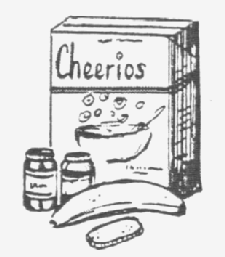
*Watch for the baby to start up-and-down chewing. Watch for her to move her tongue around. This means she is probably ready for food that takes more chewing. Try:
- Cooked fruits and vegetables. (Mash them with a fork.)
- Dry cereals like Cheerios or Kix.
- Bread and crackers in one-bite pieces.
*What food does a 4-to 6-month-old baby need?
- Baby cereal made with milk. (Do not use skim milk.)
- Fruits and vegetables.
- Breastmilk or formula.
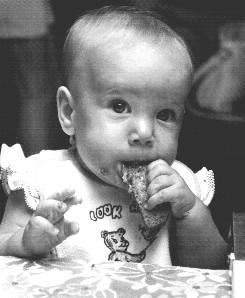
*When can a baby start eating the food grown-ups eat? You may notice the baby starting to chew like a grown-up. Also, the baby will become better at picking up food and putting it in his mouth. These are signs that he is ready for table food. Most babies will be between 7 and 10 months old at this point.
*You do not need to add sugar, salt, or spices to the baby's food.
*See the chart on page 10 for good ways to feed your baby.
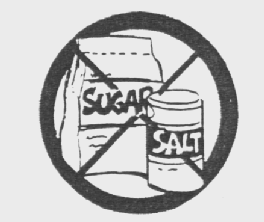
Baby food bought at the store can cost a lot. It is easy to make your own baby food. It can be better for the baby, too!
*Use fresh or frozen foods for making baby food. Canned food may have a lot of salt or sugar.

*If the food needs cooking, do it just until the food is tender. Do not cook it too long.
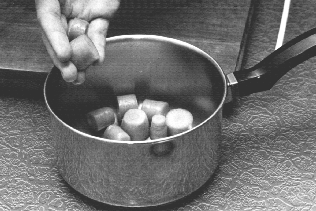
*There are three easy ways to mash the food: (1) use a baby food grinder, (2) put the food in a blender, or (3) mash it with a fork. (If it is too thick, add a little water.)
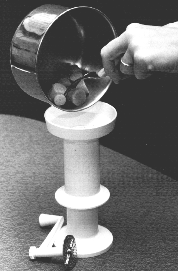

*Make small servings of baby food.
*If you put the food in the refrigerator, use it by the next day.
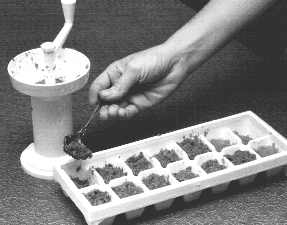
*Store the food in the freezer. Try putting the food in an ice cube tray. When it is hard, pop the "food cubes" out. Put them in a plastic freezer bag. Tie the bag tightly. Write the date on the bag so you know how old it is. Write what kind of food it is, too.
*If you put the food in the freezer, use it by 2 months.

*If you buy baby food, try to buy the ones which do not list sugar and salt in the ingredients on the label. Your baby does not need those things. Avoid baby foods with the words "Dessert" on the label.
*If your child is ready for junior food, she is ready for mashed table foods.
Materials needed:
Foods Utensils
---------------------------------------
bananas or fork
frozen peas or blender or grinder
fresh carrots pan
and water tablespoon
ice cube trays or
baby food jars
Making baby food peas:
Cook 1 cup of frozen peas. Put it in the blender or grinder with 3 tablespoons of water. Put this into 2 baby food jars.
Making baby food carrots:
Wash, peel or scrub, and cook 1 pound of raw carrots. Blend the cooked carrots in a blender or use a baby food grinder. Add 3 tablespoons of water. This should make about 2 1/2 baby food jars of carrots. Freeze the baby food if you do not plan to use it within one day. Use ice cube trays or small jars to freeze it in.
Making baby food bananas:
Mash some ripe bananas with a fork. Make only enough to use right away.
As your baby grows you can add less water to the baby food. You can blend the food for a shorter time. You can also mash or chop the food into very small pieces.
Is your child doing these things?
* Eating solid food from a spoon 3 times a day.
* Feeding herself well with her hands.
* Drinking from a cup with your help.
* Eating food from the basic four food groups at each meal. (See the chart on page 10.) * Drinking less breastmilk or formula.
If your child is doing those things, you may want to stop breastmilk or formula. This will usually be around 1 year. Give the child whole milk or 2% milk. (Ask your doctor which kind is better for your child.)
Think about mealtimes in your household.
How many family meals do you have each day? Eating can be a time for happy talking. It can be an easy time. Or it can be a time of cleaning up messes and trying to get children to eat. Mealtime should be a special time when both parent and child can grow closer. Sound wonderful? It is. Is it quick and easy? It can be. Think about these tips during mealtime.
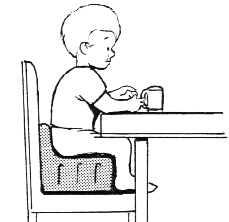
The child's chair should be even with the table. The child's feet should be resting on something. He should be able to reach his food.
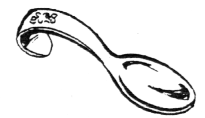
The spoon the child uses should be small. There should be no sharp edges. The spoon should have a shallow bowl. The spoon handle should be the right size for the child's hand. She also needs a cup that she can hold easily.
Meals should be at about the same time every day.
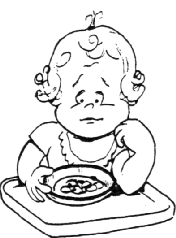
Give the child small helpings. Let him ask for more if he wants it.
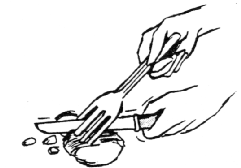
Cut the food into bite size pieces.
Make food easy to eat. Make it soft food.
Make sure the food is not too hot and not too cold.
Give new foods to the child a little at a time. New foods should come when she is happy and awake.
Meals should look good to eat. Try to put different colors of food next to each other. This way children can begin to see different colors and shapes.
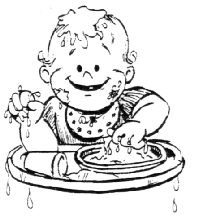
When children spill or play with their food, keep calm. Your child is learning about how food feels. As the child gets older, he can help you clean up messes.
Most important-remember that mealtime is a special time for your family to be together. Talk to your child at mealtime. Give your child new words about eating. Let her share new words with you.
List 3 things about your child's eating that make you happy. For example:
My child does not eat too much. My child likes milk. My child does not throw food on the floor. 1. 2. 3.
List 3 ways you try to keep the child doing the good things that you listed. For example:
I tell my child that I am happy when he eats his vegetables.
I show my child the right way to use a spoon.
I say "please" and "thank you" when asking for something at the table.
1. 2. 3.
Think about your main family meals during the past week. Answer these questions:
1. How many days did you eat the main meal together as a family?
2. Did you have the TV or radio on during the meal?
3. Did anyone yell at someone during the meal?
4. What else happens at mealtime?
5. Think of one way you would like to change mealtime with your family.
Talk with your family about making this change. Make a plan for making the change. You may want to ask some questions like:
What will each person do? How long should we try this plan before we decide if it is working? Remember, it takes time to change habits.
Materials needed: newspaper grocery ads
Look at newspaper ads from grocery stores. Find out if the prices for the same foods are different at each store. Make a list of food and the price at each store.
Does one store have lower prices? At which store do you shop?
Think about the food prices from the ads. If you go into a convenience store (like 7-11 or Village Pantry), look at the food prices. Which store has lower prices, the convenience store or the large supermarket?
Store A Store B
Example price price
-------------------------------------------------
1 dozen eggs
1 pound apples
1 pound bananas
1 gallon 2% milk
1 loaf bread
16 ounces cottage cheese
1 head lettuce
1 can frozen apple juice
Example of how to use chart: for 6month-old feed iron-fortified cereal-2 tsp. of rice cereal 2 times a day.
Months Food
0-4 5-6 7-9 10-12 12-36 examples
--------------------------------------------------------------------
Formula* 31/2 C. 4 c.t 21/2 C. 21/2 C.
(if not breastfed)
----------------------------------------------------------------------------------
Milk and 1/4.3/4 C. whole milk,
milk products 4 times yogurt, cheese
a day
Iron forti- 2 tsp. 3 tbsp. 4 tbsp. Rice, barley,
fled baby 2 times 2 times 2 times baby cereal
cereals a day a day a day
Breads (whole 1/2 slice Bread, toast,
grain enriched) 4 times crackers
a day hard biscuits
(1/2 c. (older child
2 times -cereal)
a day)
Vegetables 2 tsp. 2 tbsp. 4 tbsp. 1/4.1/2 c. Green beans,
2 times 2 times 2 times 2 times peas, carrots,
a day a day a day a day squash
Fruits 2 tsp. 3 tbsp. 4 tbsp. 1/4.1/2 C. Begin with
2 times 2 times 2 times 2 times applesauce,
a day a day a day a day pears, mashed
bananas. Move
into dried
apricots,
strawberries,
cantaloupe
Fruit 1/2 C. 1/2 c. 1/4.1/2 c. Apple with
juices a day a day a day water, orange
with water
Meat/meat 3-4 Eggs (yolk
substitutes tbsp. only until 1
2 times year), chicken,
a day fish, meat,
cottage cheese
-------------------------------------------------------------------------------------
*Give water to child at least twice a day and as often as child wants at other times.
+ As the child begins to eat food, decrease the amount of formula.
c. = cup tsp. = teaspoon tbsp. = tablespoon
-------------------------------------------------------------------------------------
Blossom, M. C., and Hertzler, A. 1976. Infants: Feeding is more than nutrition (pamphlet). Columbia, Mo.: Cooperative Extension Service, University of Missouri
Evers, W. 1983. Kids and food: Children's nutritional status: Are the kids all right? (pamphlet, HE-1). West Lafayette. Ind.: Cooperative Extension Service, Purdue University.
Gerber Products Company. 1979. Foods for baby and mealtime psychology (pamphlet). Fremont, Mich.: Gerber Products Company.
Lansky, V., Jacobson, J., Keane, S., Larson, N., Popehn, M., and Parker, L. 1974. Feed me I'm yours. Deephaven, Minn.: Meadowbrook.
McCann-Rugg, M. 1983. Feeding your baby during the first year (pamphlet). Urbana, Ill.: Cooperative Extension Service, University of Illinois at Urbana-Champaign.
Myers-Walls, J. 1983. Kids and food: If you don't like it, neither do I (pamphlet, HE4). West Lafayette, Ind.: Cooperative Extension Service, Purdue University.
Samuels, M., and Samuels, N. 1979. The well baby book. New York: Summit.
Satter, E. 1983. Child of mine: Feeding with love and good sense. Palo Alto, Calif.: Bull~ Publishing Co.
United States Department of Agriculture and Health, Education and Welfare. 1971. Food is more than just something to eat (pamphlet). United States Department of Agriculture and Health, Education and Welfare.
American Academy of Pediatrics-Committee on Nutrition. 1983. "Soy-protein formula: Recommendation for use in infant feeding." Pediatrics. 72: 359.363.
American Academy of Pediatrics-Committee on Nutrition. 1983. "The use of whole cow's milk in infancy." Pediatrics, 72: 253-255.
Parness. L. A. 1979. "Feeding children." Journal of Florida Medical Association, 66: 443-448.
Fomon, S. J., Filer. L. J., Anderson. T and Ziegler. E. E. 1979. "Recommendations for feeding normal infants." Pediatrics. 65: 520-559.
Fomon. S. J. 1974. infant Nutrition~n. 2nd ed. Philadelphia: W. B. Saunders.
Howie, P. W.. Houston, M. J., Cook, A., Smart, L., McArdle, T., and McNeilly. A. 5. 1981. "How long should a breast feed last?" Early Human Development, 5: 71-77.
Satter, E. 1983. Child of mine: Feeding with love and good sense. Palo Alto. Calif.: Bull Publishing Co.
Vobecky, J. S., Vobecky, J., Demers, P. P.. Shapcott, D., Blanchard, R., and Black, R. 1980. "Food and nutrient intake of infants in the first fifteen months." Nutrition Reports International, 22;571-580
Yeung, D. L., Penneli. M. D., Leung and Hall, J. 1982. "The effects of 21 milk intake on infant nutrition." Nutrition Research, 2: 651-660.
The information given herein is supplied with the understanding that no discrimination is intended and no endorsement by Purdue Cooperative Extension is implied.
RR 12/92
This publication was made possible by a grant from the Division of 3Maternal and Child Health, Indiana State Board of Health.
Consultant: William Evers, Extension Specialist, Foods and Nutrition.
Writers: Maryann O'Leary, Instructor: Beckie Golter, Karen Hinkley, and Joe Wetchler, Graduate Assistants, Child Development and Family Studies.
Illustrations by Keith Butz, Center for instructional Services.
Photography by Richard Myers- Walls, Photographic Services, Center for Instructional Services.
Cooperative Extension work in Agriculture and Home Economics, State of Indiana, Purdue University and U.S. Department of Agriculture cooperating: H.A. Wadsworth, Director, West Lafayette, IN. Issued in furtherance of the acts of May 8 and June 30, 1914. The Cooperative Extension Service of Purdue University is an equal opportunity/equal access institution.